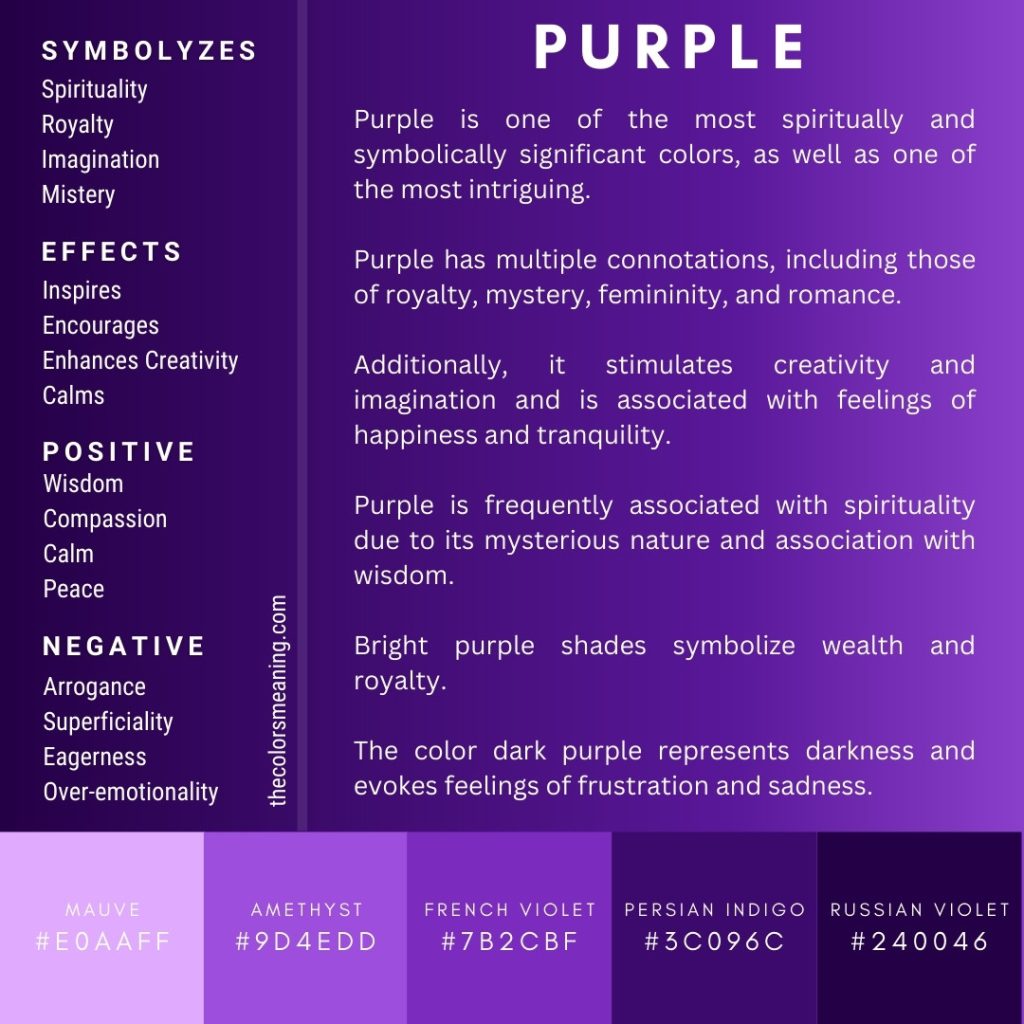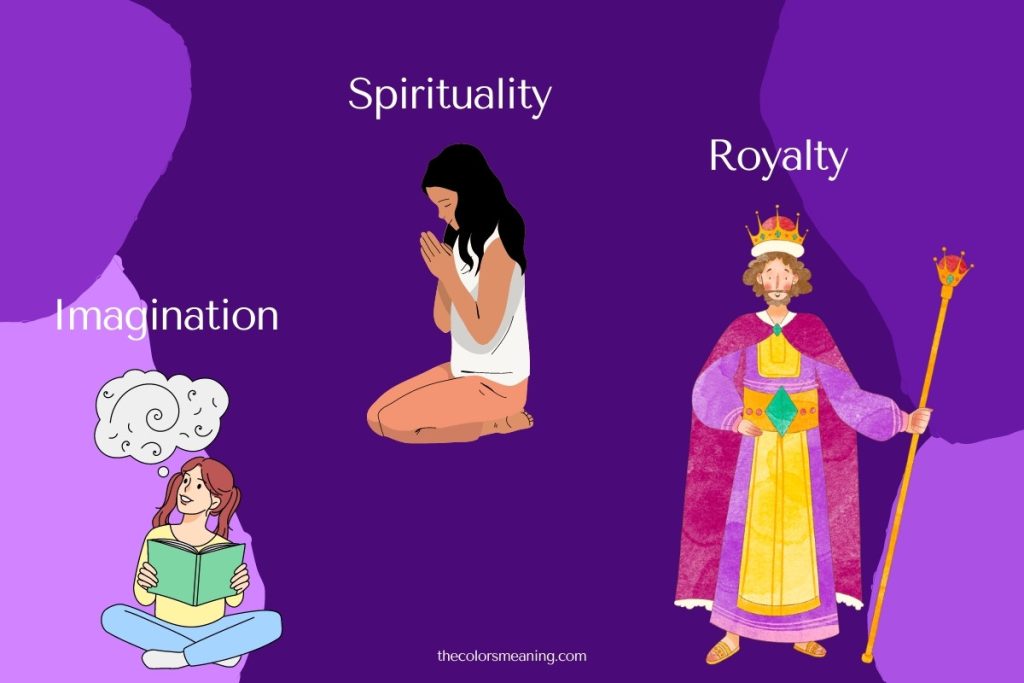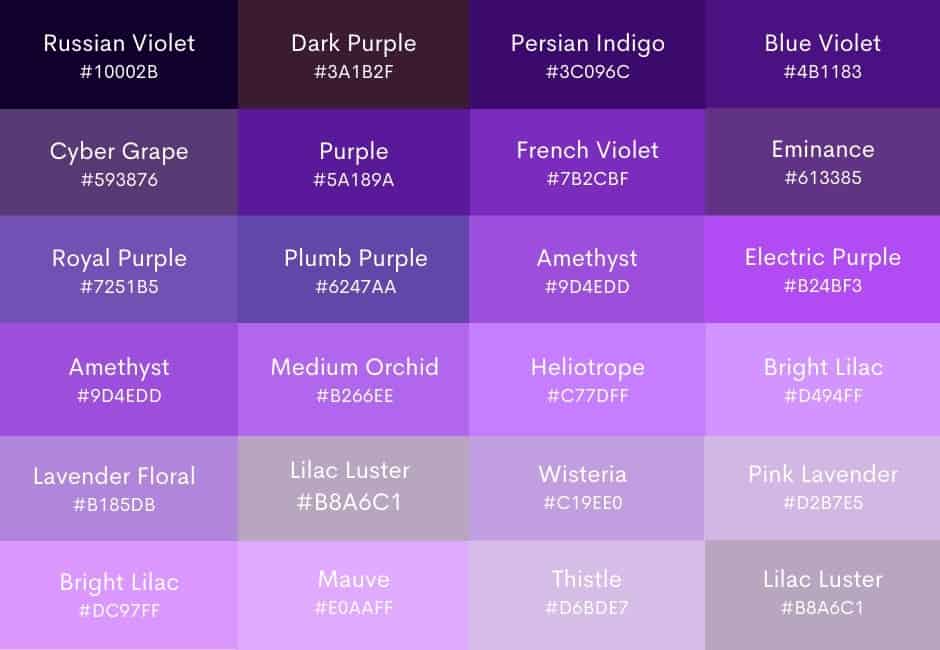If you want to know the meaning of the color purple, you’ve come to the right place. In this article, we will discuss the symbolism and meaning of purple.
Purple, the color of royalty and power, is associated with wisdom, creativity, peace, and pride. Furthermore, it is a color that represents luxury, extravagance, and pride.
So, we have prepared a detailed article on the meaning of purple, the color of mystery.
We will discuss the symbolism and meanings of purple, its uses, representative chakra, gemstones, facts, expressions, and brands with purple logos.

To embed this infographic on your website, copy and paste the code below. Otherwise, no usage rights will be granted.
<img src="https://thecolorsmeaning.com/wp-content/uploads/2022/11/color-purple-meanings-1024x1024.jpg" alt="meaning of the color purple" width="800px" border="0"><small>Like this? Discover the <a href="https://thecolorsmeaning.com/color-green-meaning-of-the-color-green" rel="noopener" target="_blank">meaning of the color purple</a> from <a href="https://thecolorsmeaning.com" rel="noopener" target="_blank">TheColorsMeaning.com</a></small>Purple Color Meanings in Different Cultures
In Hinduism, the color purple symbolizes peace and wisdom. They believe that violet enhances mental clarity by purifying the mind and body.
Catholics associate purple with Advent and Lent, two of the most important religious events on the Catholic calendar.
In Judaism, the color purple represents salvation and hope. It is associated with redemption through God. In order to honor God’s presence, they made the decision to dye their clothing this color.
Purple is associated with virtue and faith in Egypt. Purple is thought to ward off evil spirits. Additionally, women frequently wear purple to show respect for regional traditions. As a result, purple is one of the most popular colors among Egyptians.
Purple has mourning meanings in Thailand and Brazil. They express their sadness by wearing a purple ribbon around their neck.
In Africa, the color purple signifies royalty, authority, and prosperity. Because of this, the Angolan royal family has worn purple since the 18th century.
Purple is a symbol of honor in the United States.
In Asian cultures, the color violet is associated with nobility.
What Does the Color Purple Mean in the Bible?
The Bible also has meanings for the color purple.
The biblical meanings of purple are connected to majesty, royalty, and power.
Purple was the color that the ancient Israelites were most accustomed to because it is so uncommon in nature.
Additionally, during the Passion, Jesus Christ is depicted wearing a purple garment on Middle Ages symbolic monuments.
Purple is a symbol of virtue and obedience.
Purple is the color of royalty in the Old Testament.
Psychological Meaning of Purple
The meaning of purple is simply fascinating and full of symbolism. The color purple means luxury, royalty, and authority.
Purple has multiple meanings, being associated with royalty and mystery as well as femininity and romance. It also stimulates creativity and imagination and is associated with feelings of happiness and calmness.
Thus in some cultures, it is often used for special events such as weddings.
In history, purple has been associated with royalty and wealth. The reason is that purple dye was very expensive and hard to find in ancient times. So people considered purple a royal color.

In nature, purple is quite rare and can be found in grapes, eggplants, sweet potatoes, red onions, purple carrots, and certain berries.
The Phoenicians began the production of the color purple in 1200 BC, along the coast of the city of Tir, by using the shell and mucus of a sea snail of the species Murex Snail. The result was Tyrian violet, a color so beautiful that it was mentioned in Homer’s Iliad.
Due to a lack of natural resources of this color, the purple pigment was challenging to create, and the raw material was costly.
Ancient Greeks and Romans continued the production of Tyrian purple pigment until 1453 CE.
According to historian Teopomp, the purple pigment was so expensive that it was worth more than its weight in silver.
These are the reasons why the meanings of purple are associated with aristocracy and extravagance.
Purple is a color associated with royalty and wealth because only aristocrats could afford to buy purple clothes and things.
The kings of Egypt wore clothes colored Tyrian purple. Moreover, the Roman emperors Julius Caesar and Augustus also wore purple as a sign of power. Thus, at that time, only aristocrats could afford to buy purple.
The leaders love this color because it reflects prestige and power. Thus, purple is associated with leadership.
The royal meaning of purple has been preserved even today. For example, Queen Elizabeth II of Great Britain wore the Purple Robe at her coronation in 1953.
In the LGBTQ+ community, the purple on the official flag is associated with non-binary gender identity.
Color Purple Meaning
Purple has spiritual, imaginative, and magical connotations.
Purple is associated with creativity, wisdom, royalty, ambition, power, and luxury. It also has meanings related to the supernatural, independence, extravagance, pride, and peace.
What does the color purple mean? People associate purple with mystery, royalty, magic, and luxury because it is difficult to see in nature.
So, what are the most common purple associations?
The color purple has meanings related to creativity, affectivity, imagination, inspiration, and copyright. It is also associated with spirituality, enlightenment, and mystery.
Purple represents wisdom and is frequently associated with spirituality due to its mysterious nature. Depending on the hue, purple can mean a variety of things.
Depending on the hue, purple can mean a variety of things. Light purple represents romantic energies, whereas dark purple represents frustration and sadness.
Purple is associated with the introverted personality type, which is introspective, creative, and reflective. They require more alone time.
Purple aids in the elimination of anxiety, aggression, jealousy, and fear.
The color purple encourages originality, imagination, and creativity. Because of this, the various shades of this color have inspired a lot of writers, poets, musicians, and artists.
Purple is also for those who are creative, open-minded, and capable of trying great things.
Purple is also associated with bravery and courage. In order to honor soldiers for their bravery, former U.S. president George Washington established the Purple Heart in 1782.
In addition, purple has associations with various personality traits. Purple lovers are more likely to have artistic and intuitive tendencies and to pay more attention to the spiritual side of life.
Purple is frequently associated with wisdom, power, and extravagance. Purple can also represent greed, arrogance, and self-importance.
Purple is a symbol of mourning and death in some European countries.
Purple is one of the most spiritually and symbolically significant colors, and it is also intriguing and attractive.
Purple is a spiritual representation of support, harmony, and peace. Purple manifests in men as a tendency to be more spiritually expressive. In women, purple implies harmonious spiritual development.
Purple is a combination of the colors red and blue.
Purple, with the stability and calm of blue and the energy of red, is a color that inspires maturity, spirituality, knowledge, and understanding.
Purple is a blend of vibrant warm color and an excellent color that keeps both characteristics. As a result, it can stimulate imagination and creativity while also influencing mood.
Purple represents self-reflection, energization, and spiritual practice strengthening. Those with a violet aura are more connected to their spiritual path.
Due to its ability to heal, the color purple, associated with the purple chakra, is a fantastic choice for meditation.
Another excellent option for designing a unique environment for meditation is purple candles. They can also aid in the attraction of spiritually beneficial high-frequency energies.
The purple color masterfully combines the coldness of truth and the warmth of acceptance, increasing the level of wisdom that helps us make the best decisions.
Purple is associated with intuition, the compass that guides us through life’s chaos. Moreover, purple enables extrasensory abilities to utilize positive energies.
Purple symbolizes self-discovery, spiritual awareness, and self-care. In addition, it represents the ability to heal.
Purple is frequently used in color therapy because of its capacity to balance the soul and stimulate the mind.
In Feng Shui, purple represents prosperity and abundance. According to Feng Shui, Violets should be placed in the home’s southeast corner.
Purple has spirituality, the sacred, passion, fulfillment, and the higher self, all associated with its symbolism. In addition, purple, which is associated with the third eye, has different associations depending on the shade.
Light purple represents feminine delicacy and energy. It evokes romantic feelings as well.
Dark purple represents darkness and is associated with feelings of frustration and sadness.
Bright purple hues symbolize wealth and royalty.
Purple stimulates the imagination and heightens sensitivity. It is associated with the meaning of enhancing the sacred and uplifting the spirits.
The color lavender, also known as light purple, is associated with femininity, grace, and elegance. Additionally, it is connected to beauty. Because of this, it is also known as “grown-up” pink.
Aside from the mystery of purple, the color lavender represents uniqueness.
Purple inspires us to reflect because it combines mental and emotional clarity.
Because it promotes and sustains love and peace, purple has many calming effects.
In the presence of chaos, the color purple becomes extremely sensitive, affecting it emotionally.
Therefore, purple is the color of the contrasts; you can either love it or detest it.
Over 700 American parents were polled for a 2013 study published in the journal Archives of Sexual Behavior, and it revealed that while women tended to prefer red, purple, and pink, men tended to prefer the color blue.
According to the same study, purple, along with red and pink, is one of women’s three favorite colors.
Purple is one of the most popular colors among women, but it is also one of the least popular among men.
According to a study published in Genetic Engineering & Biotechnology News, color vision is linked to color cones in the eyes, which are carried on the X chromosome. Men inherit just one X chromosome, as opposed to women, who have two.
In order to see the same colors as women, men’s brains need longer wavelengths of light. This explains why violet is one of the colors that women adore the most while men dislike it the least.
The fact that purple is absent from the color spectrum makes it even more intriguing. Thus, in the absence of a wavelength interval, you perceive purple as a non-spectral color. That makes it even more unique.
Purple is an intense color with the strongest visible wavelength of the electromagnetic field and is closest to X-rays and gamma rays.
Purple is the most difficult to distinguish because it has the shortest wavelengths of all colors.
Overuse of purple can draw attention to less desirable traits like irritability, arrogance, and impatience.
Physical Effects of Purple
Purple has a number of physical effects on our health, including:
Health benefits – Purple foods are abundant in dietary fiber, vitamins, and minerals. They are also high in anthocyanin, which is useful for brain health, inflammation, and cardiovascular disease.
Enhances creativity – Violet is an excellent imagination and creativity booster.
Calming effects – Purple has a calming effect on the mind and can improve mental clarity.
Enlightening – Strongly associated with spirituality, the color purple encourages self-reflection, awareness, and self-discovery.
Personality Color Purple
How many purple things do you own? Is purple your favorite color?
Purple, as a favorite color, is said to represent the charismatic, sensitive, compassionate, and supportive person, often displaying creative thinking and imagination.
Purple people are intuitive and tend to have a spiritual bent, making them frequent daydreamers.
If purple is your favorite color, it indicates that you are a kind, free spirit. Purples have charisma; they are calming and tranquil.
The personality color purple is associated with creativity, imagination, and intuition. Purples like to be generous and friendly.
The color purple can reveal your idealistic and dreamy nature. Vision, on the other hand, can be one of your strengths.
Long-term purple exposure can make you moody.
People with a purple personality prefer to avoid the crowd and stand out with their own style.
The violet color is a free spirit who enjoys exploring the world and experiencing new cultures.
Additionally, you have good judgment when it comes to character, and you are not deceived by intuition.
The purple personality can become more balanced by practicing meditation.
One of the negative characteristics of the purple personality is arrogance.
If purple is your favorite color, you may be interested in learning more about the personality color purple.
Meanings of Purple Shades
Depending on the shade, purple can have different meanings.
Lavender: Known as “grown-up” pink, lavender is a light purple shade connected to femininity, grace, and elegance. It also represents beauty, uniqueness, and refinement.
- Lavender hex code is #A689E1
Lilac: This pale and delicate shade of purple is linked to love and affection. It can symbolize innocence, youth, and nostalgia. It is frequently used to lend an air of elegance.
- Lilac hex code is #C8A2C8
Purple: The color at the far end of the spectrum, purple is associated with royalty, imagination, and creativity.
- Violet hex code is #8F00FF
Indigo: A color whose name is derived from the plant known as Indigofera tinctoria, indigo has meanings related to wisdom, devotion, and higher knowledge. It also represents frustration or sadness.
Indigo: A color whose name is derived from the plant known as Indigofera tinctoria, indigo has meanings related to wisdom, devotion, and higher knowledge. It also represents frustration or sadness.
- Indigo hex code is #4B0082
More Shades of Purple
The most beautiful shades of purple include dark purple, persian indigo, cyber grape, lead purple, amethyst, lilac, lavender and mauve.

Being a composite color, they go up to shades of red, or blue hues.
Seeing Purple in a Dream
Dreams frequently represent our thoughts and daily activities. It is therefore important to understand the significance of the color purple in our dreams.
Seeing purple in a dream represents success, fame, and prestige. Purple, a color associated with power, can represent the end of your failures.
Our dreams of purple are unique. Purple walls, a purple dress, purple shoes, purple fruits, purple flowers, or even a purple hat might appear in our dreams. These all have various meanings.
Purple walls in a dream represent determination and independence, but they can also represent isolation.
If you have a dream of a purple dress, it could indicate that you will receive good news from your partner. At the same time, it might represent an overly developed emotional side.
If you dream about purple shoes, you are preparing for unpleasant circumstances. It could also indicate that you lack knowledge in an area of interest to you.
Wearing a purple hat in your dream may indicate that you place a high value on learning new things and performing research. On the other hand, it might indicate that you value your freedom.
In your dream, purple flowers represent good fortune, joy, and romance. Purple fruit, on the other hand, might represent your aspirations.
Most Common Uses of Purple
Purple, a color of compassion and sensitivity, is frequently used in industries dedicated to women, but it is also used in psychology, religion, and humanitarian campaigns.
Companies and Brands That Use Purple in Their Logo

Purple Chakra
Purple is associated with the Crown chakra, the last chakra of the chakra system.
The seventh chakra, also known as purple chakra or Sahasrara, is just above the head and is associated with imagination and creativity as well as with symbols of royalty and spirituality.
The violet chakra is thought to aid in establishing a connection with the Higher Self and opening up access to profound levels of spiritual wisdom and intuition.
When the violet chakra is balanced, it brings feelings of happiness, security, and emotional balance. As a result, balancing this chakra contributes to overall well-being.
An overactive violet chakra manifests as irritability, arrogance, anxiety, impatience, and headaches. Additionally, you might experience stress.
Start wearing violet gemstones like amethyst, azurite, diamond, lavender quartz, violet jasper, selenite, or violet lapis lazuli to help balance this chakra.
Purple Gemstone
Purple stones and crystals are said to enhance creativity, imagination, intuition, and wisdom. Purple gemstones include sugilite, lepidolite, amethyst, purple ruby, fluorite, purple garnet, spinel, and charoite.
- Sugilite: facilitates communication with your loved ones.
- Lepidolite: rebalances the energy fields and helps with emotional balancing.
- Amethyst: aids in self-awareness and overcoming fears.
- Purple Ruby: energy efficient, helps restore energy and reduce exhaustion.
- Fluorite: achieving clarity and logical thinking by balancing the cerebral hemispheres.
- Purple garnet: provides harmony and optimism.
- Spinel: relieves emotional problems by providing motivation and hope.
- Charoite: helps to eliminate negative energies and vibrations; also called Inspiration Stone, helps to stimulate creativity.
Facts About Purple
The U.S. Army has awarded the Purple Heart to injured soldiers for bravery since 1782.
Purple is a secondary color that is a combination of blue and red.
Purple is the complement of the color green in the RGB color model.
The fear of purple is called porphyrophobia.
Purple Day is a day commemorated in Nova Scotia, Canada, to raise awareness of epilepsy.
Only Dominica and Nicaragua have purple as one of their national colors.
Carrots are said to have been purple before the 17th century when Dutch farmers began genetically modifying them to honor king William of Orange.
Idioms With the Word Purple
Are you looking for phrases with the word purple in them? The idioms most frequently used to describe the color purple are listed below.
Born in the purple: It refers to royal family members who were born in the color purple.
Purple prose: It means overly complex writing that makes excessive use of metaphors.
Shrinking violet: It represents a person who is extremely shy.
Purple cow: It means to be born into a reigning family; it also means something amazing and remarkable.
Purple haze: This term describes euphoria that may be brought on by substances.
Purple speech: Bad language is described as purple speech.
Summary Color Purple Meaning
Purple, the color of royalty and mystery, is frequently linked to spirituality, creativity, compassion, and inspiration. It also carries connotations of prosperity, originality, and wisdom.
It is said to stimulate the mood while also calming the mind. Additionally, it may represent power and wealth.
Purple is a color with a wide variety of spiritual connotations and deep symbolism. Also associated with sensuality and femininity, it is a captivating color. It can also represent arrogance, impatience, and irritability.
Purple means: spirituality, royalty, imagination, mystery
Effects of purple: inspires, enlightens, encourages, calms
Positive traits: wisdom, creativity, compassion, mystery
Negative traits: emotional, arrogance, irritability, authority

